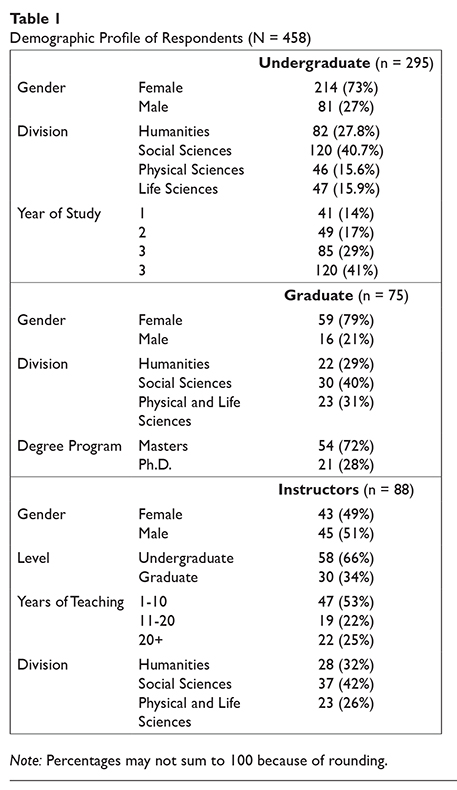
Li-Shih Huang
University of Victoria, Canada
I have gotten through almost two degrees in science and english [sic] is my first language but I rely heavily on Microsoft Word to catch my gramatical [sic] and spelling errors. I also frequently missuse [sic] words, I now wonder if it is common to have bad english [sic] among certain academic communities. (U81)
Recent work on the academic language needs of EAL graduate and undergraduate students across disciplines suggests that the skills identified as important do not necessarily correspond to students’ and faculty members’ perspectives about the skills that students need to develop (see Ellis, 2010, p. 353). My discussions regarding graduate and undergraduate EAL students’ academic language-learning needs, internally at my university’s working group on English language proficiency and Scholarship of Learning and Teaching Lecture Series, externally at international scholarly and professional conferences, and also through publications, have all prompted the same question: What about students who speak English as their first language? Would you hypothesise that the findings are parallel for EL1 students?
English for Academic Purposes (EAP) courses offered by language-support units in various academic institutions typically have EAL learners as their main constituents rather than students who speak English as their first language. Even though many accept that EAL and EL1 students may have different needs and challenges about communicating in English in academic settings, few would argue with the fact that ‘academic English is no one’s mother tongue’. Furthermore, in institutions of higher education, most language-support units provide English language support and services to both EAL and EL1 students. In the area of EAP, however, no studies have examined the needs of EAL and EL1 learners within an institutional context or used their findings as empirical supports that guide the handling of EAP support and services.
This paper reports findings about EL1 students from a research project that was designed to assess undergraduate and graduate EAL and EL1 students’ academic language-learning needs across disciplines. The project’s purpose was to inform the EAP programming offered by the university’s academic language-support unit. In addition to reporting perceptions about both language-related skill importance and the skill status of EL1 students from students’ and instructors’ perspectives, the paper compares research findings for EAL and EL1 students within the same context.
According to Savignon (1997), “Curriculum design, in whatever context, begins with needs assessment” (p. 119). Many scholars have pointed out that needs analysis is fundamental to designing an EAP course (e.g. Belcher, 2006; Elisha-Primo, Sandler, Goldfrad, Ferenz, & Perpignan, 2010; Evans & Green, 2007; Flowerdew & Peacock, 2001; Hamp-Lyons, 2001; Hyland & Hamp-Lyons, 2002; Leki, 2001; Richards & Rodgers, 1986; West, 1994). In the 1980s, when needs analysis first developed in the field of EAP, the literature identified various relevant terms (Hutchinson & Waters, 1987) and concepts (see Jordan, 1997/2005). Since then, scholars have contributed sketches of a theory of needs analysis (e.g. Berwick, 1989; Brindley, 1989), lists and taxonomies of communicative needs (e.g. Munby, 1978), and various needs-analysis frameworks (e.g. Waters & Vilches, 2001). Definitions of learners’ needs may vary, and their fundamental importance (e.g. West, 1994) and possible pitfalls (e.g. Tollefson, 1991) may be subject to interpretation and debate.
Numerous studies have examined EAL learners’ academic language needs in terms of various foci (e.g. academic literacy skills, general language skills, writing exclusively, or aural/oral communication only) and methodologies (e.g. surveys, interviews, analysis of language demands, collections of written assignments) (see Huang, 2010). Researchers have emphasised the importance of using needs assessments in the fields of ESP (English for Specific Purposes) and EAP for identifying students’ needs during the processes of curriculum development, pedagogical task design, materials development, and so on. Although needs-assessment surveys may lack specificity (e.g. Hyland, 1997), their contribution as starting points for identifying learners’ learning needs in organising new curricula and revising existing programmes in the areas of EAP and foreign-language learning has been well recognised (e.g. Cowles, 1998; Flowerdew & Peacock, 2001; Glisan, 1987; Knowles, 1994; Liu, Chang, Yang, & Sun, 2011; Long, 2005; Richterich, 1983). This recognition has generated various studies that are part of the EAP research landscape (see Evans & Green, 2007; Jordan, 1997/2005). Among the large-scale studies pursued by researchers, Littlewood and Liu (1996), Hyland (1997), and Evans and Green (2007) (which involved a total of 8,775 participants) have provided a broad picture of undergraduate students’ EAP challenges, and each study identified academic writing as among the main sources of difficulties from both students and instructors’ perspectives. These studies, however, were situated within the context of Hong Kong.
Much can be learned from previous studies that have addressed needs surveys conducted at the undergraduate level in other contexts and the few needs assessments focused on students at the graduate level, but it may be misguided to assume that what is representative of one institutional or cultural context is unquestionably applicable to another institutional or cultural context. As has been pointed out previously (Huang, 2010), needs analysis is “context-dependent and context-specific”, considering the different linguistic cultures and institutional contexts (p. 535). Furthermore, conducting a needs assessment is a sound first step toward gaining a broad picture of needs to move toward an empirically substantiated approach that will support undergraduate and graduate students’ development of academic language skills.
As for EL1 students’ academic language-learning needs (e.g. Ginther & Grant, 1996), most literature has been published in composition or communication journals, with a main focus on writing, and appropriately so, because academic writing ability is valued in the academy, and EL1 students’ ability to listen and speak is recognised without question. Since Behrens’ (1978) work, which presented faculty members’ perceptions that EL1 students’ ability to read and write was declining, with issues ranging from “insufficient evidence”, “disorganization”, and “incoherence” to an inability to construct grammatical, correctly punctuated, and well-formed sentences and paragraphs, studies have focused almost exclusively on writing skills (e.g. Eblen, 1983; Hale et al., 1996). According to researchers, instructors often express concern that graduate students are entering their programmes without basic writing skills, that students lack an understanding of writing expectations, and that both instructors and students often assume that undergraduate writing skills will transfer to the graduate level (see Harris, 2006).
In the context of developing and managing an academic English language support centre, needs assessment, which researchers have acknowledged as a defining feature of ESP and EAP (Dudley-Evans & St. John, 1998; Flowerdew & Peacock, 2001; Johns & Dudley-Evans, 1991; Jordan, 1997/2005), can be defined as seeking, interpreting, and applying information about learners’ needs (Graves, 2001). This article presents an analysis of data from a survey that focuses on both instructors’ and students’ perspectives about EL1 students’ needs and skill levels across four language domains in the area of EAP learning. In addition to discussing the findings from the present study focused on EL1 students, findings from this study and those of EAL students from a previous study (Huang, 2010) will be compared, because, apart from the void of research addressing such a comparison, most academic language-support units are mandated to provide support to both EL1 and EAL students.
For comparison purposes, the research questions mirror those examined in the study involving EAL undergraduate and graduate student and instructor groups. The importance of language skills and assessments of students’ ability of those identical language skills were gauged from both students’ and instructors’ perspectives. The relationships between how the participant groups regarded the importance of skills and how they assessed their skill levels in terms of whether support is needed in developing those skills were evaluated.
1.Students’ Perspective: What academic communication skills do graduate and undergraduate EL1 students regard as important?
2.Instructors’ Perspective: What academic communication skills do instructors regard as important across disciplines and in specific disciplines at the undergraduate and graduate levels?
3.Instructors vis-à-vis Graduate Students and Undergraduate Students: What overlaps and differences among the skills in the four language domains (reading, writing, speaking, listening) do instructors and students regard as important (graduate instructors vs. graduate students and undergraduate instructors vs. undergraduate students)?
4.Students’ Perspective: What academic communication skills do graduate and undergraduate EL1 students identify as needing additional support?
5.Instructors’ Perspective: What academic communication skills do instructors who teach undergraduate and graduate students identify as needing additional support among their students at the undergraduate and graduate levels?
6.Instructors vis-à-vis Graduate Students and Undergraduate Students: What overlaps and differences are there among the skills in the four language domains that instructors who teach undergraduate and graduate students and students at the undergraduate and graduate levels identify as needing additional development?
7.What is the relationship between the importance ratings and the skill status ratings in the four language domains assigned by instructors who teach undergraduate and graduate students and the ratings assigned by the undergraduate and graduate students’ groups, respectively?
Data were collected through three versions of self-report, web-based questionnaires.1 Undergraduate and graduate student versions were completed by EL1 students at the undergraduate and graduate levels respectively, and the faculty version was completed by faculty members who teach undergraduate and graduate students. A letter of invitation to complete the survey was emailed to individuals belonging to each of the three participant groups, following the university’s ethical guidelines (Protocol Number 07378). Taking into account the number of respondents from each group that accessed its respective questionnaires and the number of respondents who then completed them, completion rates for graduate and undergraduate students were 66 percent and 60 percent respectively, and the completion rate for instructors was 75 percent.
A total of 458 respondents voluntarily and anonymously completed the web-based questionnaires: 370 EL1 students (295 undergraduate and 75 graduate) and 88 instructors (58 teaching at the undergraduate level and 30 at the graduate level). The questionnaires asked those who responded to provide importance ratings for academic language skills, to assess their own or their students’ skill status, and to respond to open-ended questions. Table 1 presents the demographic characteristics of the respondents.

To facilitate comparisons of EAL and EL1 students’ needs and self- and instructor-assessments of skill status at the institution, the same set of questionnaires, adapted and modified from Rosenfeld, Leung, and Oltman (2001), as reported in Huang (2010), was used for all participant groups. Briefly, the questionnaire for graduate students included 45 ratable skill statements; 11 each were related to the reading, writing, and listening domains, and 12 were related to the speaking domain. For undergraduate students, the questionnaire included 43 ratable skill statements, with 11 each related to the reading, listening, and speaking domains, and 10 related to the writing domain. The two additional items included in the survey completed by graduate students were discipline-specific writing (e.g. proposal writing, thesis/dissertation writing) in the writing domain and conference presentations in the speaking domain.
Intra- and inter-rater inconsistency in responding to a Likert-format item2 is always a potential issue (Alderson, 1992; Block, 1998; Schaffer & Riordan, 2003). In the case of the former, respondents may not perceive the weight of each semantic label and its accompanying number in the same manner; in the case of the latter, respondents may have inconsistent or contradictory responses to different items. In light of the argument that individuals do not interpret items in a questionnaire and the accompanying Likert scale in exactly the same way, first, a mean rating of 4.00 or higher (i.e. very important and extremely important)3 was selected as a cut-off point. The argument can be made that this rating provides a stronger reference point for identifying important skills. For the skill status items, an unambiguous label (I need help vs. help is not needed)4 minimises inter-rater inconsistency, but does not eliminate potential intra-rater inconsistency. Further, Cronbach’s alpha statistics (Cronbach, 1970), which were computed for each section, indicated that the questionnaires have satisfactory internal-consistency reliability (i.e. α values of 0.7 or greater), with the following α values for the skill importance section: reading (0.83), writing (0.93), speaking (0.91), and listening (0.89). For the skill status section, the values were: reading (0.90), writing (0.94), speaking (0.95), and listening (0.92).
Quantitative analyses were conducted using SPSS Version 16.0 for multiple levels of analysis: (a) analyses by groups (i.e. undergraduate students, graduate students, and instructors), which were followed by (b) subgroup analyses that included divisions5 (i.e. humanities, social sciences, physical sciences, and life sciences), (c) language-skill domains analyses (i.e. reading, writing, speaking, and listening), and (d) analyses of individual skill items within each of the four skill domains.
Means, standard deviations, and standard errors were computed for each task statement in the Importance Rating Scale and the Skill Status Rating Scale for all participant groups. As in the previous study, a mean rating of 4.00 (very important) or higher was selected to distinguish the most important skills from those of lesser importance. As for the language-skill status section, mean ratings below 3.00 indicate areas where respondents reported needing help in skill development (Huang, 2010). To assess differences among discipline divisions in each respondent group’s importance ratings for the four skills, data were subjected to a one-way analysis of variance (ANOVA). If significant differences were found, then a follow-up test was employed for post-hoc mean comparisons to estimate the level of differences between means (Tabachnick & Fidell, 1989). To identify the level of agreement in skill status ratings, Chi-square tests and crosstabs were used to discover the extent of agreement/disagreement between students’ and instructors’ skill status ratings. Pearson correlational analyses examined the relationship between how respondents rated the importance of language skills and their own or their students’ skill status at both graduate and undergraduate levels. An alpha level of 0.05 was used to determine significance.
The qualitative analyses included labeling, categorical aggregation, direct interpretation, and identification of patterns and themes (Wolcott, 1994). Each response in the open-ended questions section (i.e. Would you judge that you are in need of academic communication skills training? If so, what might those skills be? Describe some of the academic communication challenges you are encountering.) was first categorised into one or more appropriate language-skill domains (i.e. reading, writing, speaking, or listening-related). When two or more language domains were mentioned in one response, individual comments were categorised according to their appropriate language-skill domains; when duplicate comments were offered by the same participant in response to the questions, only one occurrence was included. Within each language-skill domain, individual comments were then coded according to their themes. Recurring challenges within each language-skill domain were then identified to illustrate the main challenges that members of each participant group expressed for comparison purposes.
The results are presented following the research questions this study set out to examine; specifically, the importance ratings of academic language skills, the ratings of students’ skill status in the four language domains from the students’ (i.e. both graduate and undergraduate) and instructors’ perspectives, and relationships between the two sets of ratings (i.e. the importance of skills vis-à-vis skill-status ratings).
Graduate EL1 students’ perspectives Graduate EL1 students judged 34 of the 45 (i.e. 76%) ratable skill statements on the questionnaire to be very important (i.e. a mean rating of 4.00 or higher). Figure 1 presents the proportion of skill items in each skill domain ranked by the graduate students as very important, and Table 2 presents the top-five skill items.
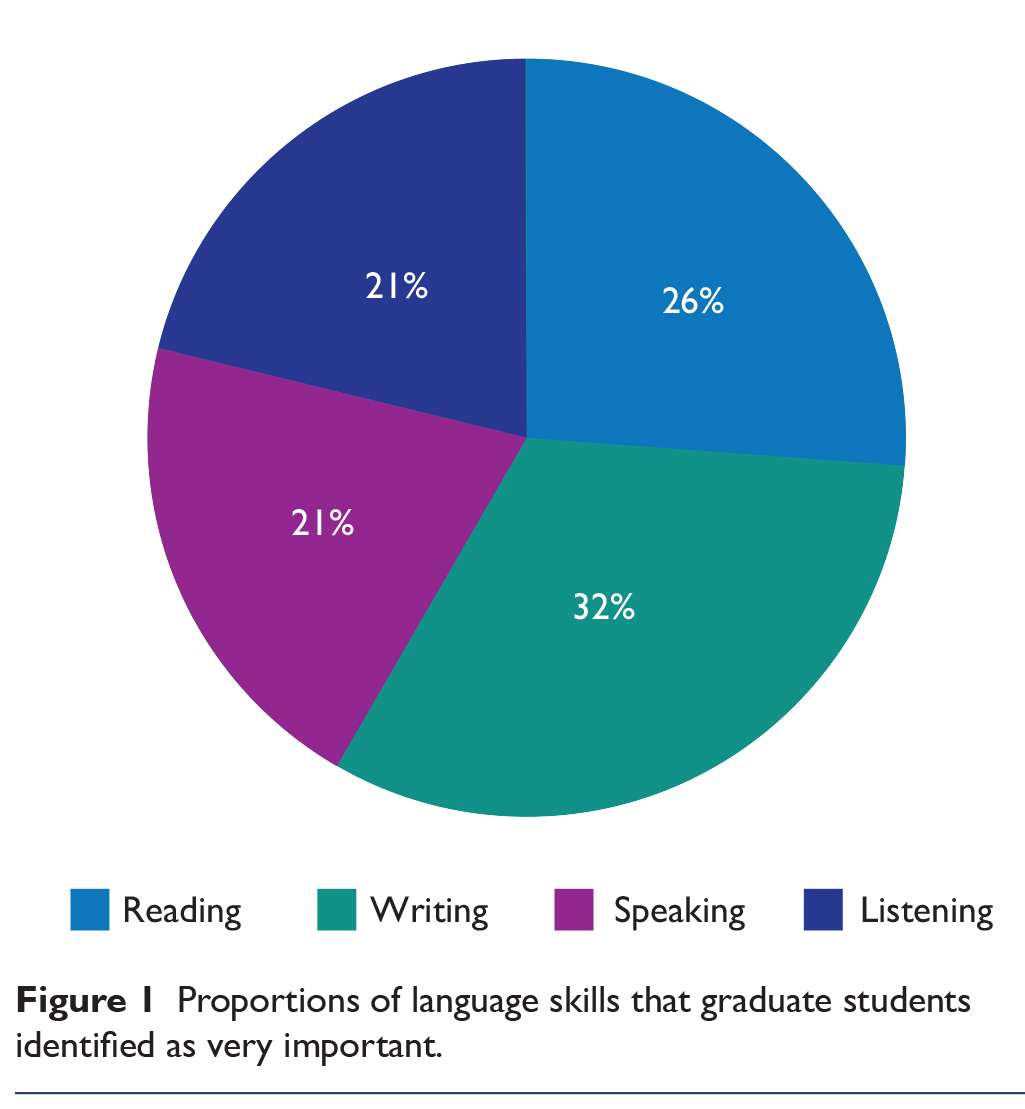
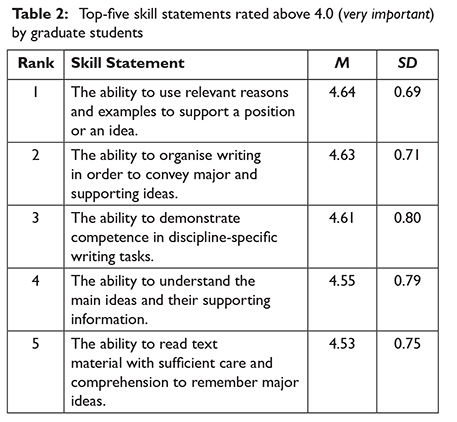
Graduate students across divisions shared only one skill in common as being among the top-five most important: the ability to use relevant reasons and examples to support a position or an idea, with a mean that ranged between 4.73 and 4.52. The ANOVA indicated that differences in graduate students’ overall rankings of the importance of the four language domains were not significant across divisions (p >0.05).
Undergraduate EL1 students’ perspectives Undergraduate EL1 students judged 13 of the 43 (i.e. 30%) ratable skill statements on the questionnaire as very important. Figure 2 displays the proportion of the number of skill items in the four language skill domains rated as very important by the undergraduate students, and Table 3 present the top-five skill items.
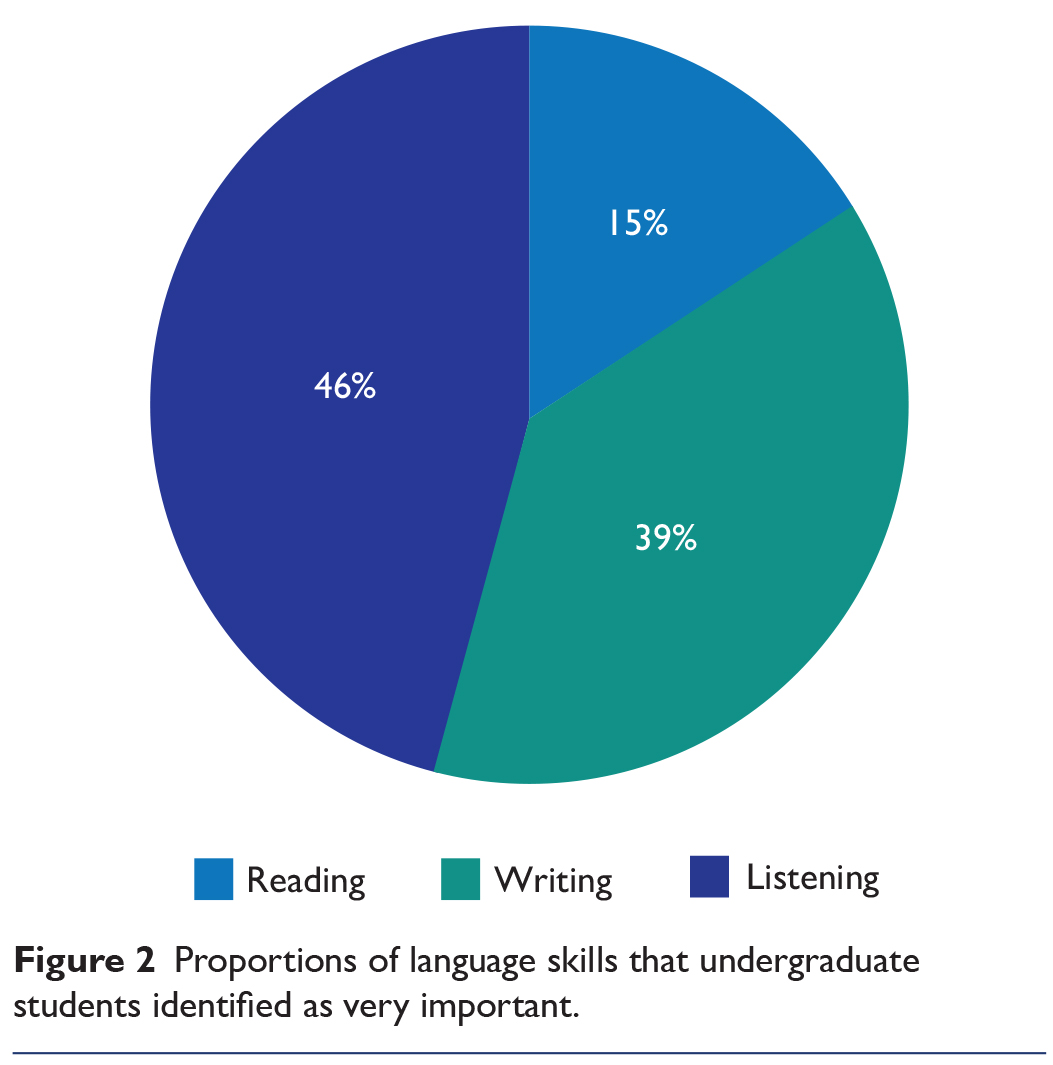
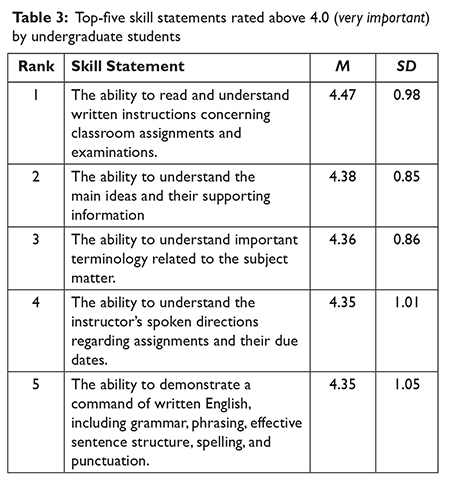
Analyses across divisions showed both similarities and variation in relation to individual skill items. For the top-five skill items across all four language domains, no single skill was shared by undergraduate students across divisions. Students in the divisions of humanities and social sciences indicated the same two skills in the writing domain (i.e. related to the use of relevant reasons and examples to support a position or an idea and to the demonstration of a command of written English). In contrast, students in the physical and life sciences divisions shared an additional skill in the reading domain: the ability to read and understand written instructions concerning classroom assignments and examinations. The ANOVA indicated that differences in undergraduate students’ overall rankings of the importance of the four language domains were significant across divisions (Reading: F[3, 291] = 11.829, p = 0.000; Writing: F[3, 291] = 16.308, p = 0.000; Speaking: F[3, 291] = 6.806, p = 0.000; Listening: F[3, 291] = 2.955, p = 0.033), with significant result from the post-hoc tests at the p < 0.05 level and the importance of writing (M = 3.98, SD = 0.80) ranked higher than listening (M = 3.95, SD = 0.78), followed by reading (M = 3.71, SD = 0.77) and, finally, speaking (M = 3.47, SD = 0.91).
Instructors’ perspectives: graduate level Instructors who teach students at the graduate level rated 34 of the 45 skill statements on the questionnaire (i.e. 76%) as very important. Figure 3 shows the proportion of skill items ranked as very important in each skill domain, and Table 4 presents the top-five skill items.
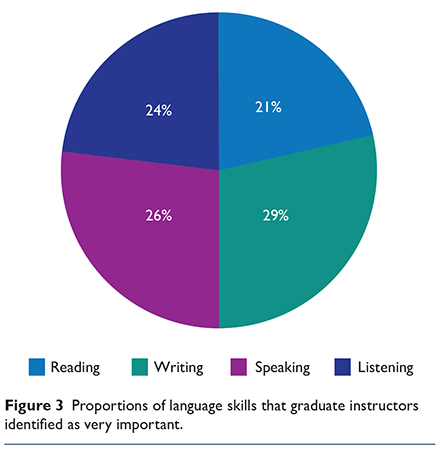
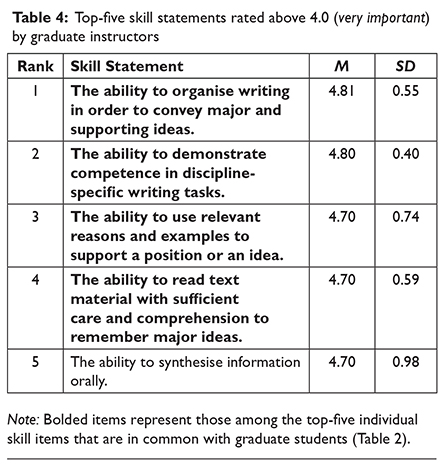
An analysis of data by divisions revealed that instructors teaching at the graduate level judged a large set of skill items (ranging from 62% to 93% across divisions) of the total ratable items as very important. One writing-related item (i.e. the ability to organise writing in order to convey major and supporting ideas) was shared by instructors from all divisions as one of the top-five skill items across all language domains. Overall, the ANOVA confirmed nonsignificant differences across divisions for the four language domains (p > 0.05).
Instructors’ perspectives: undergraduate level Instructors who teach students at the undergraduate level rated 15 of the 43 (35%) skill items on the questionnaire as very important. Figure 4 presents the proportion of skill items across the four skill domains, and Table 5 presents the top-five skill items.
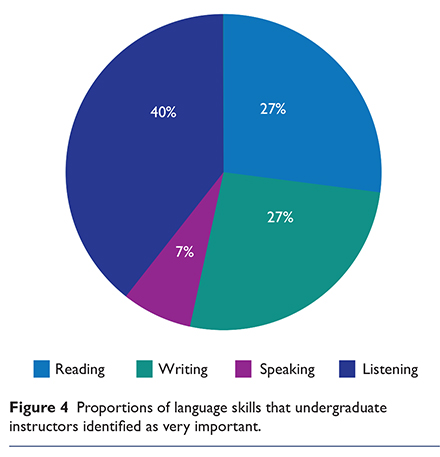
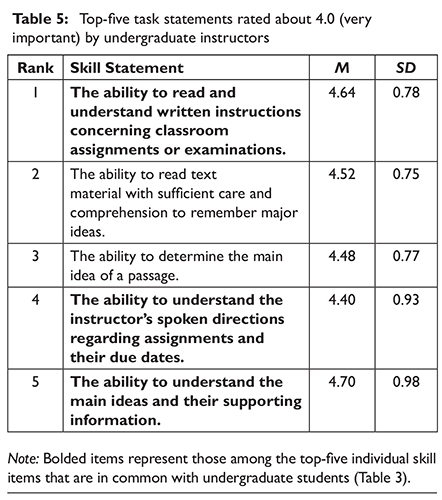
In terms of analyses of specific divisions, unlike the instructors who teach at the graduate level, instructors at the undergraduate level rated a much smaller set of skill items as very important. Among those items, instructors shared none of the skills in the writing or speaking domains; two reading-related and five listening-related skills were common across all divisions. One reading-related item (i.e. the ability to read text material with sufficient care and comprehension to remember major ideas) was shared by instructors from all divisions as one of the top-five skill items across all language domains. Overall, the ANOVA confirmed nonsignificant differences across divisions for all four language domains (p > 0.05).
Comparing individual skill items that graduate students and graduate instructors rated as very important, 94% of those identified by the graduate students overlapped with those identified by instructors, and 97% of those identified by the graduate instructors overlapped with those identified by graduate students. Only two skill items identified by graduate students, one in the writing domain (i.e. the ability to produce a sufficient quantity of written text appropriate to the assignment and time constraints), and one in the reading domain (i.e. the ability to read text material with sufficient care and comprehension to answer questions) were not shared by instructors teaching at the graduate level. Only one skill item in the listening domain that was identified by the instructors as very important (understand the parts of lectures, discussions, or conversations) was not indicated as such by the graduate respondents.
Comparing the individual skill items that undergraduate students and undergraduate instructors rated as very important, 86% of those identified by undergraduate students overlapped with those identified by the undergraduate instructor group, and 73% of those identified by undergraduate instructors overlapped with those identified by undergraduate students. Only two skill items in the writing domain that undergraduate students identified were not indicated as such by instructors: the ability to produce a sufficient quantity of written text appropriate to the assignment and time constraints and skill related to grammar, phrasing, effective sentence structure, spelling, and punctuation. In comparison, two items in the reading domain, one in the writing domain, and one in the speaking domain that instructors identified were not shared by the students at the undergraduate level: the ability to determine the basic theme (main idea) of a passage; to read text material and outline important ideas and concepts; to write in response to an assignment and stay on topic without digressions or redundancies; and to synthesise information orally.
Overall, the ANOVA indicated that comparisons of neither graduate students with instructors at the graduate level nor undergraduate students with instructors at the undergraduate level differed significantly from each other in relation to the four skill domains and on each individual skill items rated very important in the four language domains. In addition, there were no significant differences in importance means across divisions for graduate students and both instructor groups (p > 0.05).
All participant groups were asked to rate the same skill items across the four language domains (i.e. reading, writing, speaking, and listening) that they completed in the Importance of Language Skills section, but this time, they were asked to identify skill items that they (as students) or their students (as instructors) considered as being in need of support or help (i.e. M < 3.00).
Overall, graduate EL1 students identified only one item (i.e. demonstrate competence in discipline-specific writing tasks) as being an area that needed help. By divisions, graduate respondents from the divisions of humanities and social sciences identified the same writing skill as in need of development. Respondents from the division of humanities also identified the ability to use appropriate transitions to connect ideas and information as an area needing help. Undergraduate EL1 students, on the other hand, did not see themselves as needing development of any skills, as indicated by the fact that the means for all skill items were above 3.00.By divisions, respondents identified only one additional speaking skill, making presentations in class, as needing development.
Graduate instructors rated 22 (49%) skill statements below 3.00. Figure 5 illustrates the proportions of skill items across the four skill domains that instructors identified as being those with which their students needed help.
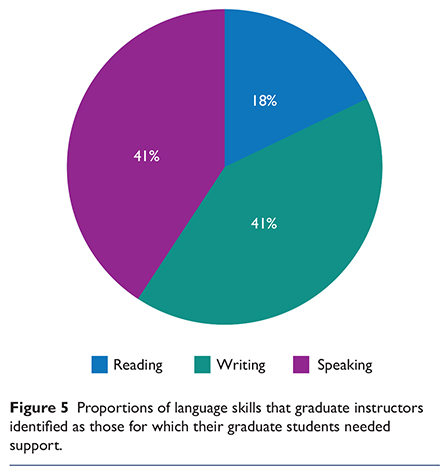
The top-ten skill items that graduate instructors identified as areas where graduate students need the most help include seven skills in the speaking domain related to, for example, summarising information, giving and supporting opinions, synthesising information (with M ranged from 1.71 to 2.13), and three skills in the writing domain that involve proper grammar, organising writing in order to convey major and supporting ideas, and showing an awareness of audience needs and writing to a particular audience or reader (with M ranged from 2.57 to 2.71).
Undergraduate instructors rated 38 (88%) skill statements below 3.00. Figure 6 illustrates the proportion of skill items across the four skill domains that instructors identified as being those with which their undergraduate students needed help. The top-ten skill items that were identified as areas where undergraduate students needed the most help, however, included seven items in the speaking domain related to, for example, orally summarising information, comparing and contrasting ideas, and giving and supporting opinions (with M ranged from 1.49 to 2.25), and three items in the writing domain related to the ability to produce writing that effectively summarises and paraphrases the works and words of others, to demonstrate a command of written English, and to organise writing in order to convey major and supporting ideas (with M ranged from 2.16 to 2.36).
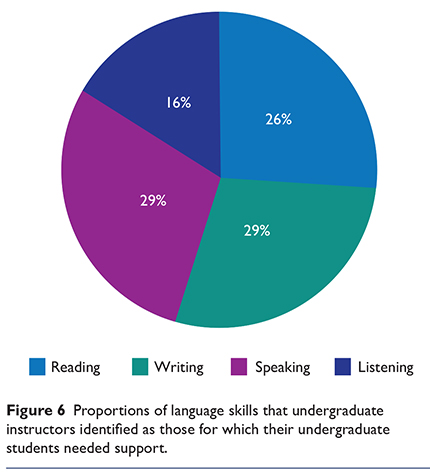
A comparison between students’ self-assessments and instructors’ assessments of their students indicates dramatic differences. In addition to, as previously presented, the differences between the instructor and the student groups in the number of skill items identified as needing support, among the items that showed divergence, results from the Chi-square tests showed that 36 and 16 items across the four language skill domains were statistically significantly different between the student and instructor groups at the undergraduate and graduate levels respectively (p < 0.001). Table 6 presents examples from the cross-tabs analyses, which identified skill items that differed dramatically in relation to the proportions of instructors who assessed their EL1 students as needing help and of students who assessed themselves as needing support with developing the skill. Overall, the proportion of students who self-assessed each of the four skill domains differed significantly from the proportion of the instructor group for both the graduate (p < 0.05) and undergraduate (p < 0.001) levels (Table 7).

This section presents the results6 from the open-ended questions, which show that, consistent with ratings from the skill status section, only eight graduate students and 23 undergraduate students indicated that they need help. This low level of perceived needs seem to corroborate findings from their skill status ratings. However, 285 individual undergraduate respondents and 73 of the graduate respondents proceeded to elaborate on the skills that they may need to develop or improve.
Graduate and undergraduate students’ comments Of the 75 comments that graduate students provided, skills related to the reading domain were mentioned 87 times, speaking 75 times, writing 97 times, and listening six times. Reading-related comments from graduate students mainly concerned the ability to read critically and how that skill is relevant to their performance in other areas, for example: “I am in great need of academic training – reading critically (big one) to help me write literature reviews and publish in peer-reviewed journals” (G28); and “I need help learning how to read a very interdisciplinary journal” (G76). Overall, comments related to writing concerned both sentence- and discourse-level needs; for example: “I guess I can use some training in writing grant proposals” (G45); “writing clearly and succinctly about a topic is a challenge. Citing information within a balance of own ideas and research. I think I am struggling to find my own voice in writing” (G39); “concise language and elimination of superfluous material” (G60); “my grammar and sentence structure needs work. My papers often come back with the word ‘awkward’ written on them. I can’t identify my awkward sentences from my non-awkward ones!” (G58).
Similarly, undergraduate students’ 139 comments addressed the challenge and need to improve reading skills, 133 concerned writing, 101 were related to skills in the speaking domain (e.g. engaging in discussions, making presentations), and 10 were in the listening domain. Comments related to reading also focused mainly on the ability to read critically. For example: “My reading comprehension is terrible! Critical reading and writing go hand-in-hand and are very important to being a successful student. These skills could be taught specifically and explicitly” (U206). “I guess could benefit from skills pertaining to reading critically – I don’t always understand the deeper meaning outlined in articles” (U14); “If I were to sit down and read a chapter of a text book, and then you asked me what I had read, I would have great difficulty summarizing the information” (U136); and “I have a great deal of trouble reading critically – picking out main points and themes and understanding the main idea of the paper” (U225). Undergraduate EL1 students tended to state writing-related comments very broadly, related to areas such as task-specific skills (e.g. writing book reviews, reports, essays) or narrowly focused on surface-level issues, for example: “I find it difficult to use APA appropriately...” (U268); and “I can use some help in understanding proper grammar for written assignments” (U81).
Instructors’ comments In the 63 comments related to challenges that their students face, members of the instructor group mentioned writing-related issues 82 times; this total was followed by reading (38 times), speaking (15 times), and listening (six times). Instructors were emphatic about the need for greater attention to be paid to writing and critical reading skills. Comments related to writing focused on a broad variety of general and specific, basic and advanced, and distinct and overlapping issues ranging from mechanics, formatting (e.g. follow a style guide), content (e.g. topic development), and organization (e.g. structuring of ideas), to task-based skills (e.g. summaries, reviews, research papers, lab reports, and emails), styles (precision, concision, discipline-specific styles), and discipline-specific writing (e.g. research and grant proposals, discipline-specific language conventions and formats, journal articles, and theses).
To illustrate the above wide-ranging key writing-related issues raised by the instructors that emerged from the data, some comments included the following: “many undergraduate native English speakers have poor grammar and writing skills” (T24); students are “lacking in the ability to use APA style to cite resources and create a reference list correctly” (T19); “they are unable to write in response to an assignment and stay on topic” (T38); “they are deficient in sentence structure and composition as well as grammar, spelling, and organization of papers” (T29); “they do not know how to build an argument using evidence” (T13); “students need to learn how to write for specific audiences and purposes” (T56); they need help “making the transition from writing for classes to writing for peer-reviewed journals” (T2); “being able to clearly express technical details to a non-technical audience is a major issue” (T7); and “attention to detail when revising their work to achieve clarity, accuracy, conciseness, and precision seems somewhat alien to them” (T12). Comments on other language domains related to reading and speaking included, for example: “95% of my students could use specific assistance around how to read the quantity and density of graduate level readings” (T20); “unable to synthesize information, and express opinions and ideas clearly in class discussions” (T62); and “responding and answering questions precisely and directly during discussions” (T34).
For the student groups, results from the open-ended section revealed important insights regarding the needs across all four domains, but seemed to indicate that there were greater perceived needs for support than the results from the surveys conveyed; whereas for the instructor groups, the expressed needs for students to develop their skills in the four domains were generally consistent with those gathered from the surveys. For the former, the act of filling out a 43- to 45-item survey twice (i.e. one on rating the importance and one on assessing their level of support needed) may have provided opportunities to reflect on and raise awareness of their own EAP needs.
Correlational analyses of the relationship between the importance of language skills ratings and skill status ratings showed that, for the graduate student and instructor groups, the correlations were nonsignificant for each of the four language domains (p > 0.05). For the undergraduate student group, however, the results showed significant, positive correlations with each of the four respective skill domains (reading: r(295) = 0.253, p < 0.001; writing: r(295) = 0.221, p < 0.001; speaking: r(295) = 0.201, p < 0.001; and listening: r(295) = 0.218, p < 0.001).
Division-wise, only the reading domain showed a significant correlation between the importance of language skills ratings and skill status ratings for both the graduate and undergraduate student groups in the division of humanities (graduate student: r(23) = -0.462, p < 0.05; undergraduate: r(82) = 0.334, p < 0.05). For the writing and speaking domains, only the undergraduate student group had a significant correlation between the importance of language skills ratings and skill status ratings in the humanities and social sciences divisions (writing: humanities r(82) = 0.383, p < 0.001; social sciences r(82) = 0.201, p < 0.05; speaking: humanities r(82) = 0.029, p < 0.05; social sciences r(82) = 0.188, p < 0.05). For the listening domain, correlations were significant for the undergraduate student group in the humanities (r(82) = 0.381, p < 0.001) and physical sciences (r(47) = 0.351, p < 0.05) divisions.
Results from correlational analyses that examined the relationship between the individual skill importance items and the skill status items indicated that, for the graduate student group, three skill importance items and their respective skill statuses were statistically significantly correlated. Of those, one was in the writing domain (r(75) = 0.228, p < 0.05) and two were in the speaking domain (r(75) = 0.247, p < 0.05; r(75) = 0.289, p < 0.05). For the undergraduate student group, 33 skill importance items and their respective skill statuses, which include nine each in the reading (the values of the correlation coefficient, r, ranged from 0.398 to 0.153), writing (r ranged from 0.160 to 0.280), and listening (r ranged from 0.114 to 0.244) domains and six in the speaking (r ranged from 0.187 to 0.259) domain, were significantly positively correlated (p < 0.001).
For the graduate instructor group, eight skill importance ratings and their respective status ratings were significantly correlated: three in the reading domain, four in the speaking domain, and one in the writing domain. Of those ratings, two were significantly negatively correlated: the ability to produce writing that effectively summarises and paraphrases the works and words of others (r(30) = -0.371, p < 0.05) and to speak clearly and accurately enough so that the instructor can understand (r(30) = -0.371, p < 0.05). For the undergraduate instructors group, 11 items were significantly correlated (nine positive and two negative), with two in the domain of reading, one in writing, five in speaking, and three in listening. The two negatively correlated items were related to the ability to distinguish between important information and minor details (r(58) = -0.386, p < 0.05) and to give and support opinions orally (r(58) = -0.289, p < 0.05). Note that a negative correlation between skill importance ratings and their respective skill status ratings means that, for those items rated as more important, there was a greater perceived need for help on those items.
Overall, the results from the correlational analysis at multiple levels (i.e. by language domains, divisions, and individual skill items) clearly indicated that the relationships between the importance of language-skills ratings and skill-status ratings are varied and complex. Most importantly, what instructors and students considered as important skills to possess, or what was perceived as a key language domain within a division or across a level of studies, might not be areas where instructors or students perceived that help was needed, as evidenced by those items with significant positive correlations. To further illustrate how the perceptions differed between what is important (i.e. skill importance ranking) and where support is needed (i.e. skill status ranking), Table 8 provides a summary of the instructors’ and students’ overall rankings.
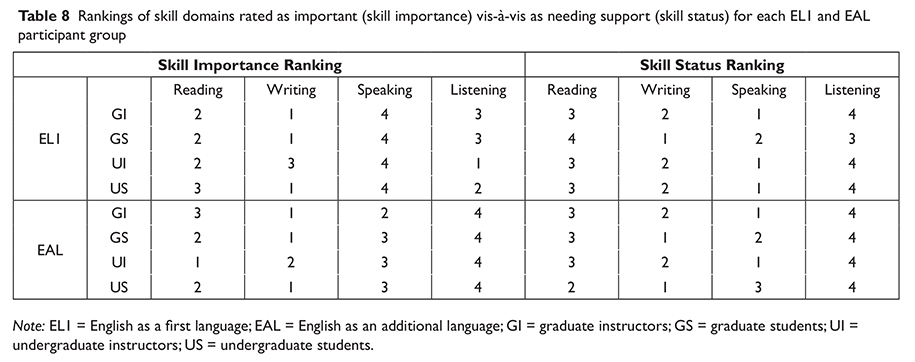
As stated in the introduction, this paper set out to examine the EAP needs of EL1 students at the graduate and undergraduate levels and then briefly compare the findings between EL1 and EAL groups, given that most language-support units established by academic institutions across North America have the mandate to support both EL1 and EAL students. Seeking ways to best accommodate and support the needs of EL1 and EAL students is the central concern of most EAP practitioners and language-support-unit administrators.
Results from the EL1 section confirmed that, similar to the findings from the EAL study, there was much overlap in the skill items identified as very important between students and instructors at both the undergraduate and graduate levels. Overall, both EL1 graduate and undergraduate student groups identified three or four fewer important skills than the EAL student groups (graduate: 34 vs. 37; undergraduate: 13 vs. 17, respectively). For the graduate student groups, all but one item, which was related to showing an awareness of audience needs and writing to a particular audience or reader, was considered a very important skill by the EL1 group, but not the EAL group. In the speaking domain, the graduate EAL group perceived the ability to make presentations at conferences; to understand the parts of lectures, discussions, or conversations; and to give instructions and directions orally as very important skills, a perception that the graduate EL1 group did not share. For the undergraduate student groups, the four items that the EL1 undergraduate student group did not rate as very important related to the ability to write in response to an assignment and stay on topic without redundancies, to use background knowledge and context to understand unfamiliar terminology, to determine the main idea of a passage, and to read text material with sufficient comprehension to answer questions. For the instructor groups, those who taught graduate EL1 students identified 34 items (vs. 40 for those teaching EAL students), and those who taught undergraduate EL1 students identified 15 (vs. 22 for those teaching EAL students). Those teaching EAL students identified a similar but larger set of important skills. Overall, students and instructors from both the EL1 and EAL contexts seemed to share an understanding of what language skills are important for satisfactory degree completion at both the undergraduate and graduate levels.
Also consistent with findings from previous studies in the field, a comparison of percentages of instructor and student groups (refer to Figures 1, 2, 3, and 4) indicated that they perceived writing as the most important skill domain. Findings from the open-ended questions section further indicated that skills and issues related to writing are still EL1 students’ and instructors’ primary concern. This emphasis on writing is also reflected in the support that institutional language-support units offer and in the research activities devoted to writing in both first- and second-language writing fields (e.g. Bridgeman & Carlson, 1983, 1984; Evans & Green, 2007; Horowitz, 1986; Jenkins, Jordan, & Weiland, 1993; Leki & Carson, 1994, 1997; Leki, Cumming, & Silva, 2008; Silva, 1993; Zhu & Flaitz, 2005).
Many scholars, mainly those in the field of second-language writing, have pointed out that writing may be strategically, rhetorically, cognitively, linguistically, and socio-linguistically different for EAL and EL1 students (see Silva, 1993), while others (e.g. Friedlander, 1990; Matsumoto, 1995) have maintained that EL1 and EAL students engage in the writing process in the same way. A comparison of findings from the EL1 and EAL contexts provides a rationale for merging EAL and EL1 students at the graduate and undergraduate levels when they share academic language-learning needs. Similarly, as Swales and Feak (1994) have argued, although there are some differences between graduate and undergraduate writing demands, the general requirements of graduate writing apply, in the sense that students at both levels must read extensively, complete assignments, and engage in other tasks in order to complete course requirements. Unique to graduate-level students is the need to master discipline-specific genres so that they can participate in the academic discourse community. If teaching academic writing in disciplinary contexts is not possible, then workshops that use the genre awareness approach designed to help students across divisions acquire genre awareness or metacognitive understanding of genre elements might be helpful. Students across disciplines can then transfer this awareness to the analysis of writing tasks in their own contexts (Beaufort, 2007; Clark & Hernandez, 2011; Devitt, 2004; Jarratt, Mack, & Watson, 2009). Applying the same argument in the other language domains, some of the mutual, generally required academic language skills identified for EL1 and EAL students may be covered as a broad area. For example, critical reading skills, which studies in both the EAL and EL1 contexts have indicated as an area deserving more attention, can be applied across disciplines and levels of studies. This possible merging does not mean sacrificing the targeted support that meets individual needs, however.
In regard to similarities, workshops could focus on skills that are the basis for effective academic communication and that students consider as important and needed (e.g. discussion skills, punctuation, supporting ideas, clear organisation or specific genres and their organisation, and writing to a particular audience). In regard to differences, workshops could focus on those important skills that a particular learner group needs (e.g. self-editing strategies, grammatical issues common to EL1 students, rhetorical and stylistic strategies appropriate to EL1 or highly proficient EAL students). As one student suggested:
I would like to see academic writing workshops that have a level appropriate to advance [sic] users of the language and native speakers. Parallel construction, idioms, construction of complex sentences, clarity and conciseness, and other topics that are adequate for someone with more familiarity with the English language. (G42)
In language domains other than writing, EL1 students’ competencies are often accepted as given, an acceptance that may not reflect instructors’ perceptions of their students’ realities or students’ perceptions of their own realities, as the current findings suggested. Language-support programmes thus should carefully consider skills that may have been neglected in other domains (e.g. the ability to give and support opinions during discussions and to summarise information orally) in addition to writing. As reported earlier, the top-five individual skills identified by each respondent group in the EL1 context related to all skills in the four language domains, and, in many cases, skills in the writing domain were not perceived as the most important, as the results from the Language Skill Status section demonstrated. In addition, skills in the reading domain were rated in the present study as more important than skills in the speaking domain and also more important (cf. needed most help) than skills in the listening domain for all respondent groups, except for the undergraduate student group.
Workshop designs that can effectively address EL1 and EAL students’ commonalities and heterogeneity in the four language domains deserve consideration and further research to empirically substantiate the insights gained from the studies. Further analysis involving objective sources (e.g. work produced by learners) would be the natural next step to address both common and distinctive needs of EAL and EL1 students at different levels of EAP proficiency. Results from the EL1 section, like findings from the EAL study, indicated a great divergence between students’ self-assessments and instructors’ assessments of their students’ skill status.7 Numerous studies have pointed out the mismatch between students’ perceived needs and instructors’ perceptions of what their students need (e.g. Eslami, 2010; Huang, 2010; Sherman, 1992; Thorp, 1991; Zhu & Flaitz, 2005). The teacher-learner gap that pervaded the EAL context also seemed to hold true for the EL1 context, regardless of language proficiency (refer to Table 6). In addition, similar to findings from the EAL context, results from the correlational analyses in the EL1 context suggested that, overall, the essential skills identified may not necessarily correspond to skills that students or instructors perceive as being in need of support across language domains and divisions.
Findings from the current study further point to the complexity of needs assessment for understanding what skills students of different backgrounds consider important, what skills instructors consider important, how students self-assess their learning needs, how instructors assess their students’ needs, and what the actual learning needs are in response to the different types of tasks that students are required to accomplish in their respective degree programmes. The fact that data gathered from the skill importance ratings may not correspond to data from the skill status ratings further emphasises the need to be cautious when interpreting and implementing programmes based on findings from needs-analysis research, as well as the importance of involving multiple sources of data in conducting needs assessment. Insights gained from the opened-ended questions also underscore the importance of not neglecting individual participants’ needs that may be lost in calculating any particular group’s overall means or ascertaining general trends within and comparisons between groups based on data collected in quantitative studies.
The dramatic learner-teacher gap, which appeared evident in the mismatch of students’ and instructors’ assessments or expectations in both the EL1 and EAL contexts (as well as in previous studies), leads one to question previous calls for taking steps to bridge the gap and, further, to ask whether such an endeavour would ever be possible, given the complexity of what the ‘needs’ entail (refer to, e.g., Deutch, 2003 and Liu et al., 2011 for a review of needs as a multiple and conflicting construct), the perspective (e.g. objective vs. subjective needs; wants and lacks; needs based on target situations vs. present situations; process- vs. product-oriented needs), and the methods (e.g. surveys, interviews, observations, documents analyses, and tests) that one may choose to assess those needs in a particular context (e.g. Jordan, 1997/2005; Brown, 1995; Huang, 2010; Liu et al., 2011). Instead, the focus might be more fruitfully placed on providing opportunities for identifying the gap so that teaching and learning needs could intersect. As also noted earlier, the act of filling out a survey, in both EL1 and EAL studies, provides students and instructors an opportunity to reflect on their own or their students’ academic language needs. As one student revealed:
As I was taking this survey, it occurred to me how useful it would be if some of these skills were implemented into some kind of training program for students as I think that would have helped me a lot. I still find my expectation for a grade, having written what I thought was a great paper, does not usually correlate with the actual grade I receive.
Furthermore, instead of approaching instruction and course design from the specialists’ perspective, as Belcher (2006) pointed out, a learner-centred approach gives potential users a voice in the language-support unit that aims to support them and, in this case, also encourages their engagement and participation.
EL1 students in this study seemed to self-assess more highly than instructors assessed students in their ratings; this was also the case with EAL students (cf. Wang & Bakken, 2004). Although the study did not directly match instructors and students, and the expressed needs and assessments of those needs may be context- and/or institutional specific, EL1 students’ confidence seemed to be consistent with commonly received comments and perceptions, such as that “[the] Language Support/Writing Centre is for people who are poor writers or communicators” or “the Language Support/Writing Centre is for second-language learners.” As this study and my experience working with EL1 students suggest, EL1 students are often quick to say “no” when given suggestions that they attend courses or workshops on academic communication skills, and they may not immediately perceive themselves as being in need of skill development, as also seemed to be the case in this study. These reactions are understandable because students are aware of only that which is in their consciousness, and learners’ perceptions about what they need within their consciousness often influence their receptiveness, interest, and motivation to learn (e.g. Huang, 2010; Horwitz, 1987; Morell, Sharp, & Crandall, 2002). As one instructor from the division of physical sciences shared:
I believe that the major issue in learning and excelling in academic communication for students in the Faculty of Engineering is more of an attitude problem. Most students often regard technical training as of primary importance and therefore ignore the soft skills that one should acquire at university.
One could argue that, in a sense, ‘perception’ is a version of ‘reality’; learners may not be able to accurately assess their own learning needs (cf. Ismail, 2011), or, as other researchers have pointed out (e.g. Huang, 2010; Eslami, 2010), instructors may not always be able to have an insider’s understanding of what the EAP issues are and what and how students are struggling. Still, those perceptions represent their versions of ‘reality’. Without meditational means that open the dialogue or self-reflection about what is needed in terms of one’s situation, instructors, curriculum developers, and materials developers may have to continue relying on personal perceptions, experiences, or intuitions about students’ needs when they are planning EAP courses (e.g. Spratt, 1999).
This paper represents an institution’s first and rare attempt to understand the needs of both EL1 and EAL students at both undergraduate and graduate levels that its language-support unit has a mandate to support. Such an endeavour is necessarily broad in scope for the purpose of understanding and describing each respondent group’s perceptions of their needs. The insights gained from the project have served as an important foundation for the planning of EAP workshops. Furthermore, such a level of needs analysis as that conducted for this study is a necessary first step that enables an institution to respond to its students’ needs during a time of pressing demands to manage resources efficiently and to pinpoint where further studies are needed to provide a more in-depth examination of the specific needs identified in the assessment.
As Lape (2012) stated, “all writing center directors share a similar rhetorical goal: to justify the ‘worth’ of their writing centres” (para 1). Language support units within all academic institutions have resource constraints. Not only is it pedagogically sound for instructors to begin their instruction at the place where learners perceive the greatest need and to prioritise what they teach based on information gathered from ongoing assessments (as often is requisite in corporate training or ESP contexts) in the context of an increasingly competitive environment and the need to set priorities, it is also often necessary to focus on the academic language skills that are most crucial for learners. The project was designed to capture students’ perceived academic language-learning needs, and the results from both studies have informed the practice and development of language support services at the current institution in addressing the academic language-learning needs of both EL1 and EAL students at the graduate and undergraduate levels. As Allen (2004) put it, conducting needs assessment is “critically valuable for those who are in the early stages of planning or proposing a new program” (p. 95). Further research that involves different perspectives and methods for gathering multiple sources of information is needed to better understand and identify differences and commonalities in various language domains that transcend disciplinary borders.
The American philosopher, author, and professor Allan Bloom (1987) once said, “Education in our times must try to find whatever there is in students that might yearn for completion, and to reconstruct the learning that would enable them autonomously to seek that completion” (p. 63). For students, instructors, and the institution, the knowledge gained from this needs assessment serves as the first step in guiding learners toward discovering the skills that they truly need.
1. Space limitations do not permit a reproduction of the three versions of the survey in their entirety. For a detailed account of the development of the survey instruments and sample questionnaires, refer to Rosenfeld et al. (2001) or contact the author.
2. Since the study is an exploration rather than hypothesis confirming or rejecting, it is justified to assume that the questionnaire’s Likert responses are at equal intervals. In addition, the less error variance, the higher the Cronbach alpha would be, because it is the average of all possible inter-item correlations. The high Cronbach alphas obtained indicated a high consistency among the items in terms of interval equality and the distribution normality of the item responses. For a further discussion of the Likert response format, refer to Huang (2010).
3. Ratings of the importance of the skill items included I/They do not need to perform this task (0), slightly important (1), moderately important (2), important (3), very important (4), and extremely important (5). Note that, for the skill importance scale, the higher the rating, the higher the importance.
4. Ratings of the skill status of the same skill items included I/They do not know how (1), I am not very good at this (would seek help) (2), This is not a major problem for me (would not seek help) (3), and I am/They are competent at this (4). Note that, for the skill status rating, the lower the rating, the greater the perceived need for help.
5. It is recognised that a ‘division’ is not necessarily a clearly defined or unified entity. Communication needs and practices also may vary within the same division. Four major divisions were used in the analysis for the purposes of making statistical comparisons across divisions and for programme implementation. When the categorisation was ambiguous, clarification was sought based on background information provided by the respondents or upon checking with the respondents.
6. Given that the qualitative section involves multiple participant groups, as well as multiple themes (e.g. sentence- or discourse-level writing issues) within multiple language domains (i.e. writing, speaking, listening, and reading), it would not be possible to present the qualitative results “in a themed tabulated format”, as suggested by one reviewer, without making the table excessively large.
7. Graduate and undergraduate students in the EL1 and EAL contexts responded similarly in terms of the number of items that students identified as needing support at the graduate and undergraduate levels. Instructors at both the graduate and undergraduate levels in the EL1 contexts, however, identified more skill items below 3.00 (graduate instructors: 22; undergraduate instructors: 38) than instructors in the EAL context (graduate instructors: 18; undergraduate instructor: 35).
Dr. Li-Shih Huang is an Associate Professor of Applied Linguistics and is affiliated with the Learning and Teaching Centre at the University of Victoria as its Learning and Teaching Scholar-in-Residence. Her research interests include English for academic purposes, learner strategies in language-learning and language-testing contexts, needs and outcomes assessments, and corpus-aided discovery learning.